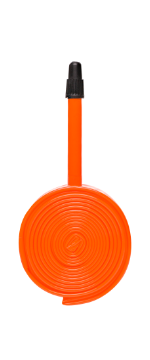 Over the last few years, a new material for inner tubes has surfaced - TPU or thermoplastic polyurethane. The first brand I noticed was Tubolito, though there are several available now.
Over the last few years, a new material for inner tubes has surfaced - TPU or thermoplastic polyurethane. The first brand I noticed was Tubolito, though there are several available now.
Since late last summer, I’ve been trying Tubolito road inner tubes on my TT bikes and on my summer bike. They seem very light, and surprisingly air tight compared to latex tubes. I’ve only used road bike tubes, which come in a couple of weight variants and valve stem length. The two weight variants are the standard Road tube (coming in at a quoted 38-40g per 18-30mm tube) and the S-Road tube (coming in at 23g per 18-28mm tube). The S-Road tubes are for disc brake wheels only.
So are these fancy and expensive TPU tubes better than the alternatives?
Rolling resistance data from the Bicycle Rolling Resistance website, who tested a wide range of TPU inner tubes from several manfacturers suggest that most TPU tubes are on a par with the best latex tubes.
Weight - TPU tubes are clearly the lightest tubes out there. I suspect the differential between TPU and butyl could be noticeable.
Air retention - In my experience, TPU tubes retain air better than latex and certainly on a par with, if not better than, butyl tubes.
Price - Looking at online retailers, butyl tubes are the cheapest out there, with quality race level tubed coming in at £7 to £9. Latex race tubes are around £15 to £20. Tubolito tubes are in the £27- £30 range. Shopping around can get you some good deals with substantial discounts, though I’s be wary of really budget tubes.
A few days ago I suffered a rear wheel puncture while riding in the Port Talbot Wheelers 2-up ’25’. In actual fact, when I went to investigate after the race, I found the side wall of the GP5000 tyre had worn away, and I think the actual cause had been that the wheel pulled sideways in the starting effort. Anyway, this offered an opportunity to try out the Tubolito TPU-specific puncture repair kit.
The kit contains some alcohol wipes, several patches of two sizes (these seem to be the same stuff that the tube is made of), and a tube of glue. Essentially the repair process is just the same as with butyl or latex tubes except you clean the tube with alcohol rather than roughen it with sandpaper, and the glue is chemically different. The link above gives instructions and a helpful video.
My first attempt at a fix seemed to work, but over a few hours, the tyre deflated. I removed the tube and checked it for leaks and found a slow leak from the edge of the patch where it clearly hadn’t stuck down properly. As with a similarly failed repair with butyl or latex tubes, this is pretty fatal for a second attempt.
One observation on Tubolito tubes is that the valve core can work loose and allow slow leakage. It’s a good idea to check these are tight before using the tube. Some of the deep rim Tubolito tubes are actually normal length valve stem tubes with extenders, and one of these extenders came slightly loose. Just something to be aware of.
For me, the weight advantage of Tubolito tubes is a 'nice to have' rather than something essential. The ride feel does seem better than butyl tubes, but I've not done a comparison with latex tubes. The rolling resistance data don't make a compelling case for TPU tubes, though I do prefer the better air retention of the Tubolito tubes over latex, and there's a definite advantage in carrying spare tubes with the Tubolitos, since they pack so small, particularly where space is at a premium, such as with a TT bike or a road bike with a saddle mounted tool roll. For my summer bike, which has disc brakes, the S-Road Tubolitos pack really small. The main caveat I have is with their repairability. The only repair I've tried didn't work well, but that may well be my inexperience.
Conclusion: nice tubes, but the jury is still out whether they are good value. They are a good option for those of us reluctant to move over to tubeless systems (I've tried tubeless, and found it to be too much hassle).
